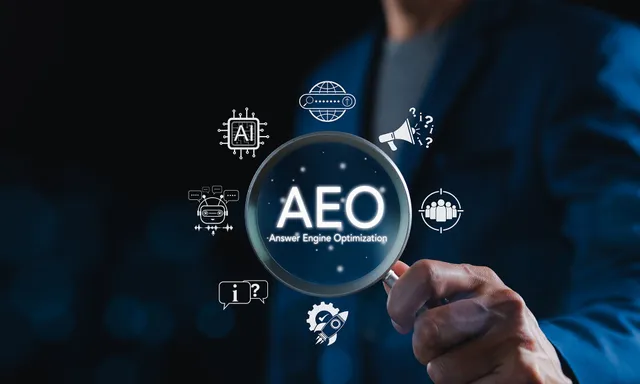What if your content could answer your customer’s questions before they even think of asking? Welcome to the world of Answer Engine Optimization (AEO), the secret weapon for businesses that want to dominate AI-driven search. Unlike traditional SEO, which fights for clicks, AEO puts your brand in the spotlight by providing instant, precise answers to real user queries across Google, Siri, Alexa, and chatbots.
In today’s fast-paced B2B landscape, decision-makers don’t have time to scroll endlessly—they want solutions now. Imagine a potential client asking, “Which CRM system is best for small B2B companies?” and your article being the first answer the AI provides. That’s the power of AEO.
This article explores everything you need to know: how AEO works, its differences from traditional SEO, key strategies, tools, challenges, and what the future holds. By the end, you’ll have a step-by-step roadmap to implement AEO for your business.
1. What is Answer Engine Optimization?
Answer Engine Optimization (AEO) is the practice of structuring and optimizing content so that AI-powered search engines provide direct, precise answers to users’ questions. Instead of aiming solely for keyword rankings, AEO focuses on user intent, ensuring your content is recognized as the authoritative source.
Key Components:
- Direct Answers – Clear and concise solutions to questions.
- Structured Data (Schema Markup) – Helps AI interpret content context.
- Logical Content Hierarchy – Well-organized headings, subheadings, bullet points, and tables.
- Question-Focused Content – FAQs and conversational formats for AI readability.
2. How Answer Engine Optimization (AEO) Works
Answer Engine Optimization functions by aligning content with the way AI-driven search engines process queries. Unlike traditional SEO, which focuses on ranking for keywords, AEO focuses on user intent and delivering accurate, structured answers.
Step 1: Understanding User Intent
AEO begins with identifying the purpose behind a search query. AI engines categorize queries as:
- Informational – Users seeking knowledge.
- Transactional – Users intending to perform an action, such as purchasing or subscribing.
- Navigational – Users searching for specific brands or resources.
Content must align with the specific type of intent to be prioritized by AI search engines.
Step 2: Structuring Content
Structured content allows AI to extract relevant answers efficiently. This includes clear headings, concise paragraphs, bullet points, and logical hierarchies. Proper content organization improves readability for both AI and users and increases the likelihood of being featured in AI-generated responses.
Step 3: Implementing Structured Data
Structured data, also known as schema markup, enables AI engines to interpret content contextually. Common types used in AEO include:
- FAQ Schema
- HowTo Schema
- Product Schema
Schema markup signals to AI what each piece of content represents, facilitating accurate extraction and display of answers.
Step 4: Delivery of Answers
Once optimized, AI evaluates content for accuracy, relevance, and authority. High-quality AEO content can appear in:
- Featured snippets in search results
- Knowledge panels
- Voice search responses
This ensures that the user receives a direct and precise answer from AI search engines without additional navigation.
Step 5: Monitoring and Optimization
AEO is an ongoing process. Continuous monitoring is required to maintain visibility and accuracy. Metrics such as featured snippet appearances, voice search performance, and content relevance must be analyzed regularly. Updates and refinements ensure alignment with evolving AI algorithms and user behavior.
3. Difference Between AEO and SEO
SEO attracts clicks, while AEO delivers answers, making your brand the first choice for AI-driven queries.

4. Key Strategies for Effective AEO
A. Understand User Intent
The first step is identifying real user questions. Tools like AnswerThePublic, SEMrush, and ChatGPT can reveal what your audience is actively searching for.
- Informational Queries – “What is AEO in digital marketing?”
- Transactional Queries – “Buy B2B email marketing software.”
- Navigational Queries – “HubSpot CRM pricing.”
B. Structure Content for AI and Readers
- Use H1-H3 headings to outline questions and answers.
- Include bullet points and numbered lists for clarity.
- Keep paragraphs short and scannable.
C. Incorporate Structured Data
Schema markup improves AI readability. Recommended types:
- FAQ Schema
- HowTo Schema
- Product Schema
D. Optimize for Voice Search
With the rise of AI-driven voice assistants like Siri, Alexa, and Google Assistant, a significant portion of searches today are voice-based. Voice queries tend to be more conversational and question-oriented compared to typed searches. To optimize for voice search:
- Use natural, conversational language in your content.
- Include long-tail keywords in the form of questions.
- Structure content clearly with headings and concise answers, making it easier for AI assistants to extract information.
E. Monitor and Update Content
AI algorithms evolve rapidly. Analyze which content is performing in snippets and voice search, and update regularly to maintain visibility.
- Regularly analyze which pieces of content are appearing in featured snippets or voice search results.
- Update outdated information, refine your answers, and expand content to cover new related questions.
- Use analytics to identify high-performing topics and gaps, ensuring your content remains relevant and authoritative.
5. Content Types Ideal for AEO
- FAQs – Direct answers to common queries.
- How-To Guides – Step-by-step instructions that solve specific problems.
- Product & Service Pages – Structured highlights of features and benefits.
- Case Studies – Show real-life solutions with measurable results.
- Multimedia Content – Videos and infographics enhance AI extraction of key information.
6. Benefits of AEO for B2B Businesses
- Improved Visibility – Featured snippets and AI responses increase brand exposure.
- Higher Engagement – Clear answers reduce bounce rates.
- Lead Generation – Direct answers build trust, driving faster conversions.
- Competitive Edge – Stay ahead of competitors using traditional SEO.
- Repurposable Content – Answers can feed chatbots, newsletters, and social media campaigns.
7. Challenges in Implementing AEO
- Constantly Changing AI Algorithms – Requires ongoing monitoring.
- Balancing Detail and Brevity – Answers must be comprehensive yet concise.
- Technical Expertise – Schema markup and structured data need technical skills.
- Content Updating – Frequent revisions are necessary to stay relevant.
8. Tools and Resources for AEO
- AnswerThePublic – Discover user questions.
- SEMrush / Ahrefs – Long-tail keywords and search intent insights.
- Google Search Console – Monitor snippet performance.
- ChatGPT / AI Tools – Generate conversational content.
- Schema Generators – Simplify structured data implementation.
9. Measuring AEO Success
- Featured Snippet Appearances – Track the number of queries where your content is chosen as the answer.
- Voice Search Traffic – Monitor growth in traffic from devices using AI assistants.
- Engagement Metrics – Bounce rate, time on page, and click-through rates.
- Conversion Tracking – Leads generated from AEO-optimized content.
10. The Future of AEO
AI search is rapidly evolving. Businesses that fail to implement AEO risk losing visibility to competitors. Key trends to watch:
- Conversational Content – Voice queries will dominate search.
- Authority Over Keywords – AI will prioritize content that demonstrates expertise.
- Interactive Answers – Videos, charts, and AI-powered demos will become standard.
- Continuous Optimization – AEO will require ongoing updates and monitoring.
Conclusion
Answer Engine Optimization is not just a trend—it’s the future of search. By aligning content with user intent, AI readability, and structured answers, B2B companies can dominate AI search results, build trust, and generate leads faster. AEO ensures your content is front and center, converting queries into qualified business opportunities while keeping you ahead of competitors.
Implementing AEO today positions your business as a thought leader in the AI-driven search era, providing both immediate answers and long-term authority.
I hope you find the above content helpful. For more such informative content, please visit TechnologyXpertise.
FAQs
Q1: How is AEO different from traditional SEO?
AEO focuses on answering questions directly, whereas SEO targets ranking for keywords.
Q2: Which content types work best for AEO?
FAQs, How-To guides, structured product pages, case studies, and multimedia content.
Q3: How does AEO improve lead generation?
Direct, precise answers build trust and authority, encouraging faster conversions.
Q4: How often should AEO content be updated?
At least quarterly, or whenever AI trends or algorithms change.
Q5: What tools can help implement AEO?
AnswerThePublic, SEMrush, Ahrefs, Google Search Console, ChatGPT, and schema generators.










